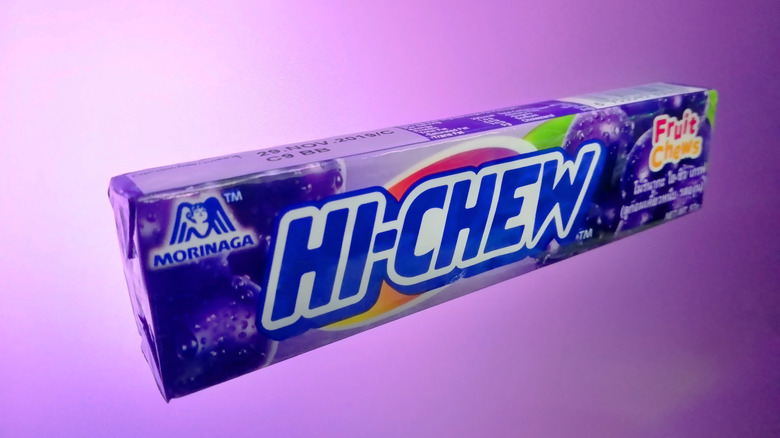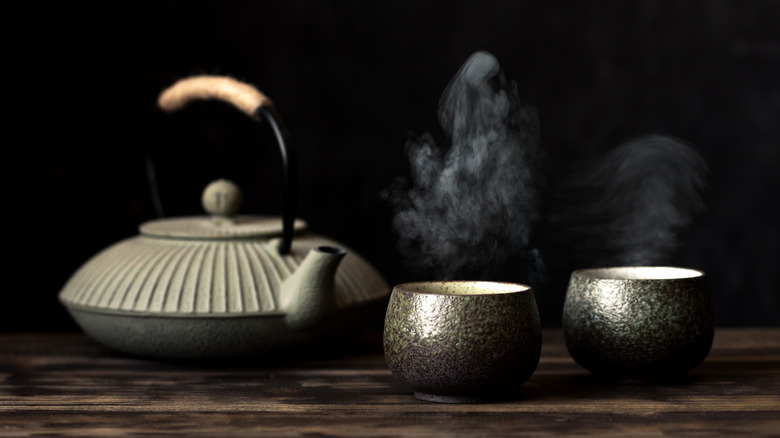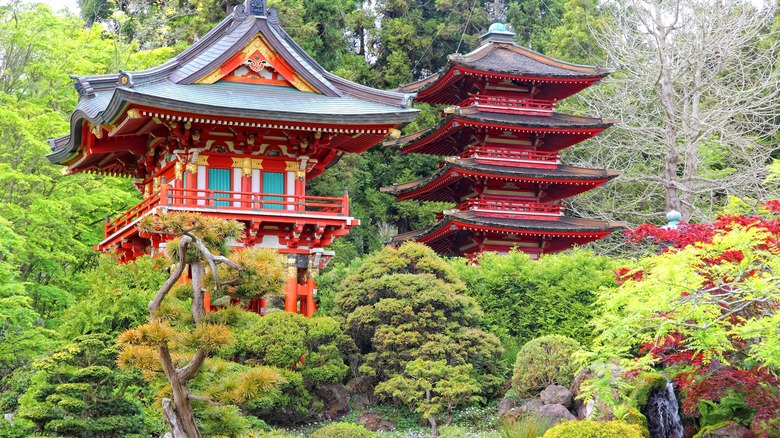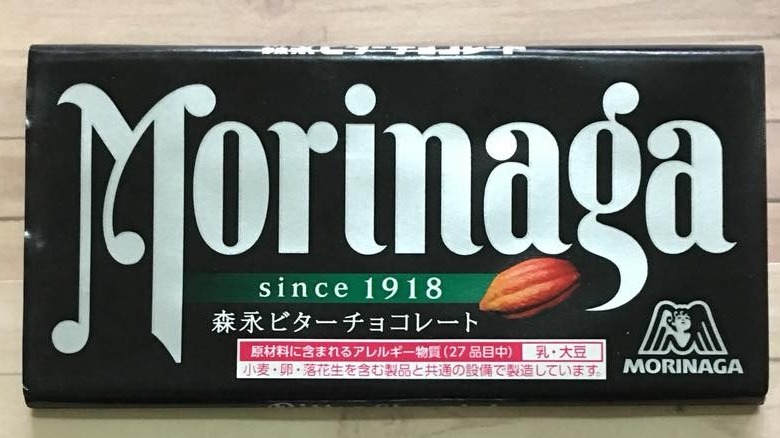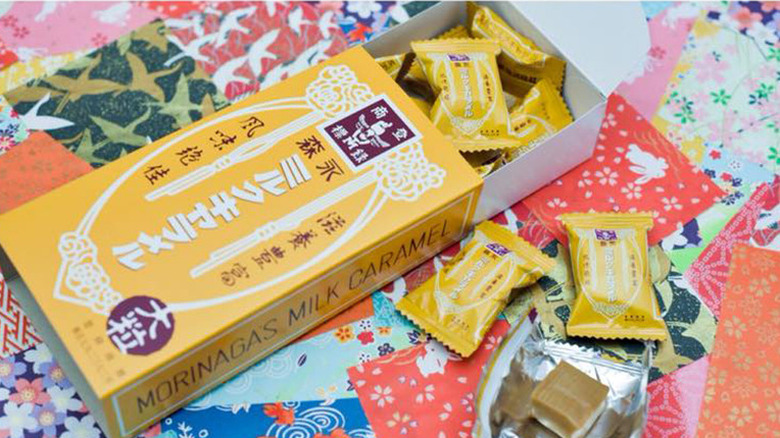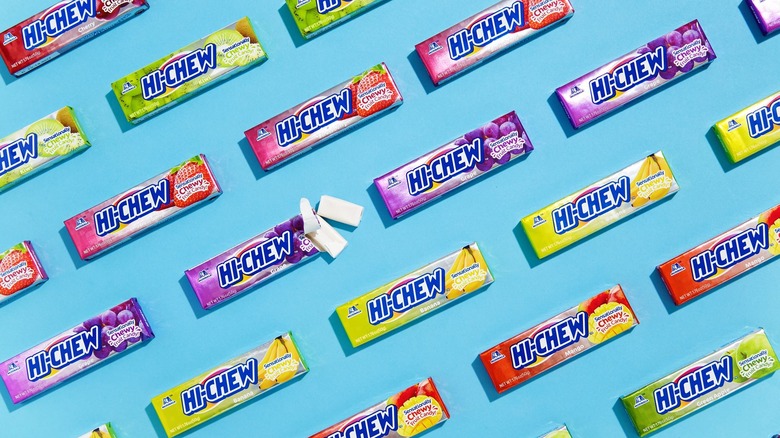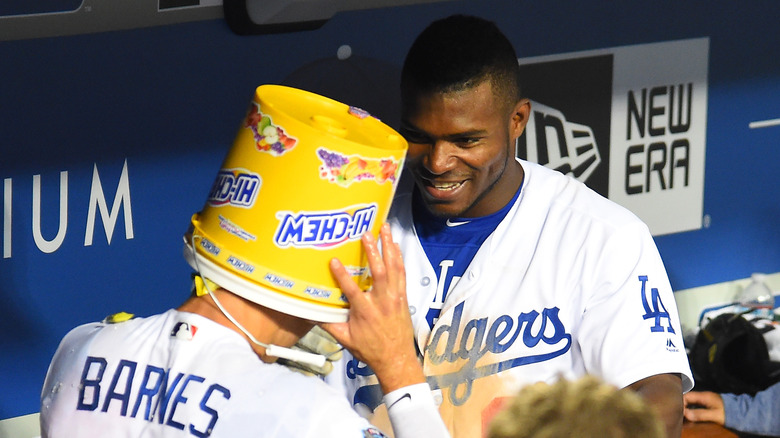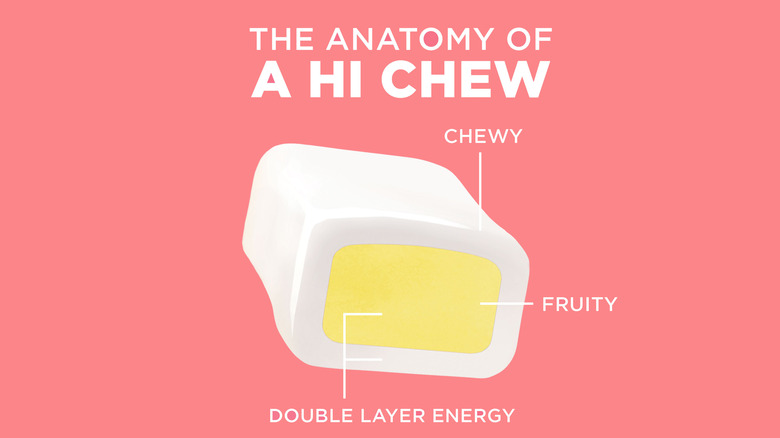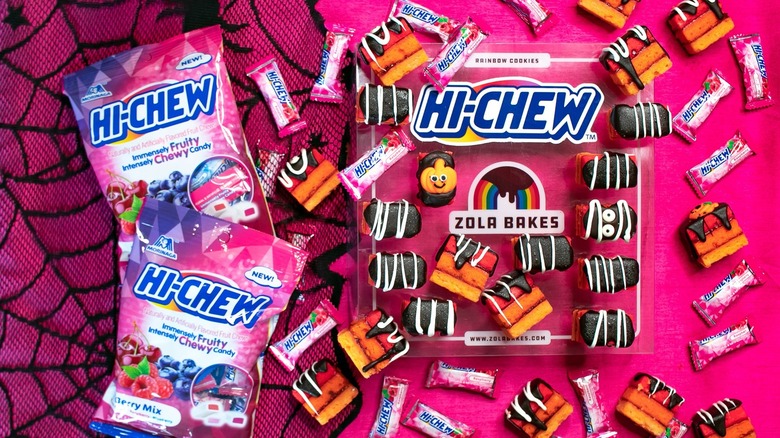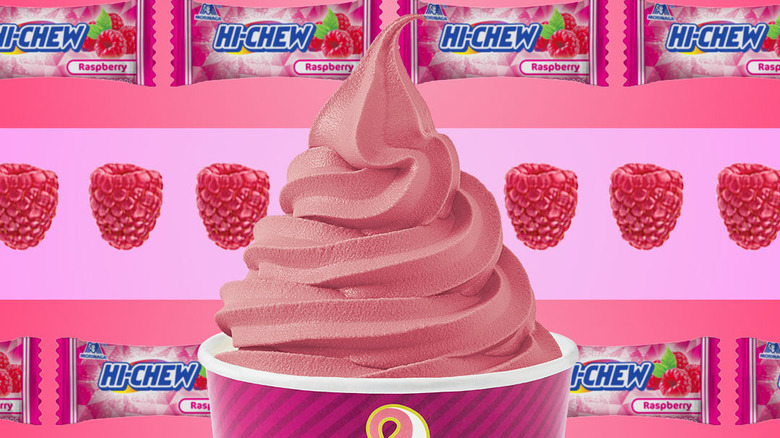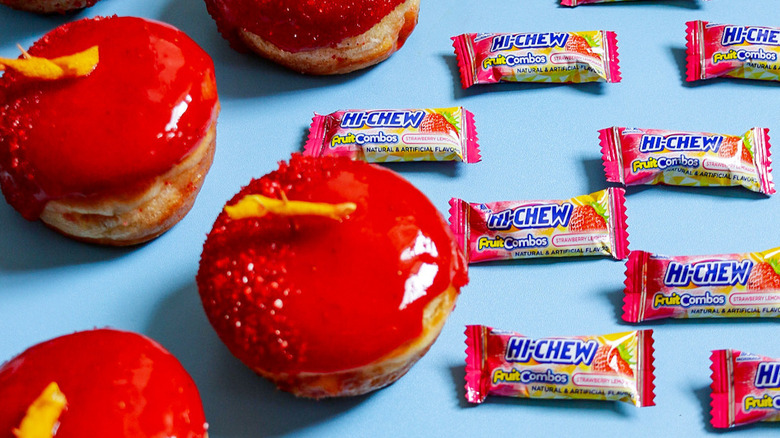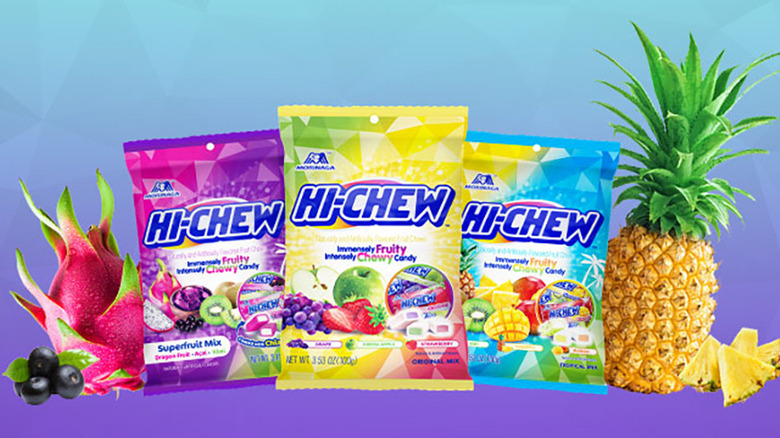The Untold Truth Of Hi-Chew
Hi-Chew is one of the most popular and oldest Japanese candy brands in the world, according to Sugoii Japan. One might think that the small, individually wrapped fruit chews are the Japanese equivalent of Starburst, but upon tasting them, the two really aren't that similar. Hi-Chew candies delight people all over the world with their fresh-tasting fruit flavors and melt-in-your-mouth texture. These candies may not be real fruit, but the intention is for them to taste as much like fruit as possible.
There are several ways that the brand goes about achieving this tasting experience — which we'll tell you all about in a bit. But more than being just a candy, Hi-Chew is a symbol of the meeting of cultures. It all began with the brand's parent company Morinaga, and a story that endlessly intertwines the cultures of Japan and the United States. Hi-Chew is the story of what it really means to share a piece of candy, as well as a Japanese man's American dream come to life.
Taichiro Morinaga was a potter as a teenager
According to the Hi-Chew website, founder Taichiro Morinaga's father died when he was just 7-years old. Without paternal support, Morinaga grew up with little resources, including education. Unable to gain help from his mother, KWR International writes that he spent his teen years working at a pottery business in Yokohama, a city just south of Tokyo. He did well and rose to a managerial position, but his kind spirit soon eclipsed his business sense. Morinaga was very sympathetic toward his customers and allowed them to take credit loans for the items they wanted. But soon enough, those loans became overdue, and his good intentions put the pottery business in dire straits. It was up to him to find a way to make up for the money that had been lost. Exasperated by the bad luck he'd had in Japan up until this point, 23-year-old Morinaga decided his chances to turn a profit would be better in America, and so he bravely set out for California in the late-1880s.
Taichiro Morinaga opened a hardware store in America
Once he got settled in San Francisco, Biz Journals reports that Morinaga opened his own hardware store in 1887, building off of his prior experience working as a pottery manager in Japan. Sadly, that too would prove to be a failure, but this time it wasn't because of his own shortcomings.
According to the National Archives, anti-Asian sentiment was strong in California at the time. Being the closest state to Eastern countries like China and Japan, the Golden State was the main landing port for 19th-century Asian immigrants. The growing Asian population there was met with a growing hatred amongst white Americans; even the law barred them from applying for citizenship. Discrimination like that meant Morinaga's hardware store saw very few patrons, and the lack of revenue led him to shut the business down. Once again, he was forced to find another way out of poverty at a time when the odds were stacked against him.
Morinaga tasted his first piece of candy in America
For once, young Morinaga was on the receiving end of generosity when an American shared a piece of candy with him one day. It was a small act of kindness, but it had a large, lasting impact. American-made candy was a luxury import in Japan that only the well-off could afford (via People Pill), and so this was the first time such sugary goodness ever touched his lips. It was a jolt of happiness and inspiration that would instill in him the passion and determination to become a candy maker himself.
But of course, the journey forward would not be so easy. According to KWR International, Morinaga's search for a candy-making apprenticeship proved fruitless because prejudiced American businessmen did not want to hire someone of Japanese descent. But if anything has been learned by now about Taichiro Morinaga, it's that he was incredibly resilient, resourceful and persistent. If he couldn't learn about the trade directly, he resolved to learn about it indirectly by taking a position as a janitor at a candy factory. When he wasn't sweeping or taking out the garbage, he was using his proximity to the professionals to glean as much information about candy making as he could.
Morinaga Western Confectionery was Japan's first modern candy company
In 1899, Morinaga felt his knowledge was sufficient enough to get started on his own, and he made plans to return to Japan. Before setting sail for home though, Morinaga wanted to gather some intel as to what kind of American candy might fare best in Japan. He asked several Japanese-Americans in San Francisco which American sweet was their favorite. The answer, according to Biz Journals, was marshmallows! Armed with this knowledge, Morinaga went back to Tokyo and embarked upon the next step of his rags-to-riches story. He started as a street vendor, fervently selling marshmallows and other confections to passersby. He called his marshmallows "angel food" (via KWR International), for their white color and light texture.
He and his sweets were so popular that the hardworking entrepreneur was able to formally launch The Morinaga Western Confectionery Shop in 1918 — Japan's first modern candy company. In honor of the marshmallows that initiated his success, as well as the Christian religion that he found and adopted while in America, Morinaga made an angel part of the official company logo. But while it may all have started with marshmallows, the company soon expanded to chocolate — and Hi-Chew would follow.
Hi-Chew candies were the solution to the rudeness of chewing gum
The company eventually expanded its candy offerings with the invention of Morinaga Fruit Chewlets in 1956. It wasn't just the desire for a fruity treat that inspired its creation, however. The advantage of Morinaga Fruit Chewlets was that one could chew them like gum, but didn't have to spit them into a trash can in public — a Japanese social faux pas. (According to Grunge, unlike Americans, the Japanese generally don't approve of eating on the go at all.) Japan is a culture with rigid social standards built upon respect and politeness, and in this, Morinaga saw the opportunity to give his fellow Japanese a tasty solution.
Morinaga's new candies — the first of which was strawberry flavored — dissolved in the mouth and could be swallowed, making them the perfect chewing gum replacement. In 1975, the treat was rebranded as Hi-Chew. Now, the soft Japanese fruit candy is known and loved around the globe, enjoyed by kids and adults alike, and available at nearly every grocery and convenience store.
The recipe for Hi-Chew was actually inspired by Morinaga Milk Caramels
Next to marshmallows and chocolates, one of the first confections produced by The Morinaga Western Confectionery Shop were caramels. Interestingly, it was actually the process for making Morinaga Milk Caramels that ultimately led to the creation of Hi-Chew soft fruit candies! People adored the sweet, milky flavor of these Taisho-era caramels, so the company adapted its formula to create similarly soft, chewy, fruit-based sweets. According to The Counter, the first Morinaga fruit chew was made by adding strawberry flavor to a piece of their caramel candy. Morinaga's research department made improvements to the recipe over the years to get them to be just right, and now Hi-Chew comes in a wide variety of flavors!
Since then, Hi-Chew has become one of the most beloved Japanese candies in the entire world — a fact reflected in the numbers. Americans eat between 700 million (according to Morinaga America and Hi-Chew) and 1 billion Hi-Chew pieces per year! That's more than 1,320 pieces per minute!
There are over 200 flavors of Hi-Chew
According to PR Newswire, there have been more than 200 different flavors of Hi-Chew as of 2021. In America, one can find flavors such as strawberry, mango, peach, grape, and green apple, to name a few. They come in rectangular, single flavor packs, as well as various types of assorted packs such as Tropical Mix, Berry Mix, Sweet & Sour Mix, and even Soda Pop, which includes Ramune (a type of Japanese soda) and cola flavors! According to FoodSided, some of the newest U.S. flavors of Hi-Chew have been decided by flavor contests, including dragon fruit (East Meets West Flavor Challenge 2018 winner) and strawberry lemonade (Fantasy Flavor Games 2020 winner). Other fresh innovations include flavor twists with real fruit pieces inside.
But while Americans (and people in other countries) have plenty of options when it comes to Hi-Chew, the brand also makes some Japan-only flavors, such as persimmon (via Japan Starts Here). There are also regional Japanese flavors, such as Okinawa pineapple and Kyushu (a large, seedless variety of orange).
A Boston Red Sox pitcher made Hi-Chew famous in America
It almost seems like poetry or fate that baseball, a sport beloved in both America and Japan, would be the bringer of success in this chewy candy story. Morinaga America, Inc. was launched in California in 2008, yet according to South Florida Sun-Sentinel, it wasn't until four years later, when then-Boston Red Sox pitcher Junichi Tazawa exposed his teammates to his favorite candy from his home country, that Hi-Chew really blossomed in the U.S.
When it was Tazawa's turn to stock up on chewing gum for his team's dugout, he threw some pieces of Hi-Chew into the mix, and the Japanese candies were an instant hit! The players loved them so much that Tazawa couldn't keep up with demand. He was proud to share his Japanese culture, but he was running out of resources. When the pitcher approached Morinaga America about bulk ordering the candy, they did him one better and gave the sweets to the MLB team for free! That was the beginning of an enduring partnership between the MLB and Morinaga America. Not only did the brand partner with the Red Sox, they also went on to form more partnerships with teams like the LA Dodgers, the Minnesota Twins, and the Chicago Cubs.
Two layers give the candy its real fruit taste
Bite into a Hi-Chew candy and you'll see that the fruit chew consists of two layers: a white outer layer and a colorful inner layer. It looks intriguing, but this unique design isn't just for visual effect. According to the company, they created the double layer to deliver the most realistic fruit taste possible.
Their goal with the white outer layer is to give customers an initial burst of "freshness," as if they were biting into an actual fruit. The colored center represents the specific fruit flavor, e.g. a light orange color to represent the mango flavor inside. This is the fruit flavor that ultimately spreads throughout the mouth. The two combined layers give candy lovers a tasting experience that is meant to mimic the real thing (with extra sweetness, of course!). According to the Morinaga company, this is a candy technology and flavor experience that customers can't find anywhere else!
Hi-Chew collaborated with Zola Bakes for a unique Halloween cookie
As demonstrated by the brand's previously mentioned MLB partnerships, Hi-Chew loves entering into unique collaborations to market its products. One such 2021 collaboration was to celebrate the launch of the brand's newest U.S. flavor, raspberry. The Japanese candy company teamed up with Zola Bakes, a New York City shop famous for making rainbow cookies, to bring their customers a special Halloween treat.
Zola Bakes came up with their own interpretation of Hi-Chew's latest flavor in rainbow cookie form. The bright red and orange layers of these limited-edition, October-only cookies were lined with raspberry jam. Each cookie was then topped with chocolate and finished off with some spooky, cute designs. But as special as this Halloween collaboration with Zola Bakes was, it isn't the only example of Hi-Chew transforming their soft fruit chews into other desserts. It also likely (hopefully) won't be the last!
Hi-Chew's raspberry flavor has been made into Menchie's froyo
The Zola Bakes Hi-Chew Halloween cookie mashup wasn't the only promotional collaboration for the Japanese brand's new raspberry-flavored chew. Turns out, this was a big campaign! Just a few months before that, Hi-Chew partnered with Menchie's Frozen Yogurt to bring a new, refreshingly tart raspberry frozen yogurt flavor to the lineup.
Actually, the deep pink-colored froyo wasn't even the first Hi-Chew / Menchie's crossover. The two brands have worked together on other flavor launches, like Hi-Chew Dragon Fruit, which came out in 2019. In 2020, they upped the ante and unveiled two new flavors at the same time! When mango and passion fruit Hi-Chew were released, Menchie's turned them into froyo flavors that could be swirled together for one cup of Hi-Chew Tropical Smoothie froyo. Clearly, these two companies are determined to find out how many ways there are to indulge in their favorite sugary treats!
Hi-Chew's strawberry lemonade flavor has been made into a donut
Not a frozen yogurt fan? That's fine, because Hi-Chew also turned one of their other new flavors, strawberry lemonade, into a donut (via PR Newswire)! They teamed up with a New York City donut shop called The Doughnut Project for an absolutely off-the-chain reinvention of their fruity candy. Dubbed the Strawberry Squeeze, this super indulgent donut combined the sweet, juicy flavor of strawberry and the bright, tangy flavor of lemon in a filling made with strawberry jam and lemon curd.
But the craziness didn't stop there. The exterior of the limited edition donut was decadently topped with a glossy, bright red Hi-Chew Strawberry Lemonade candy glaze, shimmery strawberry sugar granules, and a lemon twist for good measure. Summer fresh flavors and fried dough came together for one unbelievable sugar sensation, leaving everybody asking: Just how many ways are there to eat Hi-Chew? If the Japanese candy company keeps its momentum up, there could be even more magnificent confectionery innovations on the horizon.
Hi-Chew officially has some of the best packaging in the world
Japanese companies have some of the best packaging designs in the world. Bright colors and lovable characters make all kinds of Japanese sweets and snacks totally irresistible. (Think of the adorable, panda-shaped, chocolate-filled cookies by Meiji Hello Panda, for instance.) Likewise, the people at Hi-Chew aren't just master candy makers, but also master designers and marketers. As if their many baking and frozen yogurt collaborations weren't enough proof of that, Nielsen IQ took it upon themselves to make it official.
Hi-Chew was one of only 12 brands in the world to win a 2020 Global Nielsen BASES Design Impact Award, which recognizes just how much a food package redesign has increased dollar sales in the market. Translation: Hi-Chew's latest packaging design looks so awesome that it skyrocketed the brand's sales and brought major cash flow into the candy industry. The candy's incredibly vibrant, colorful packaging connects to the customer, conveying the juicy, flavorful morsels inside. It's literal eye candy — and it's difficult to resist. Founder Taichiro Morinaga would be proud!
